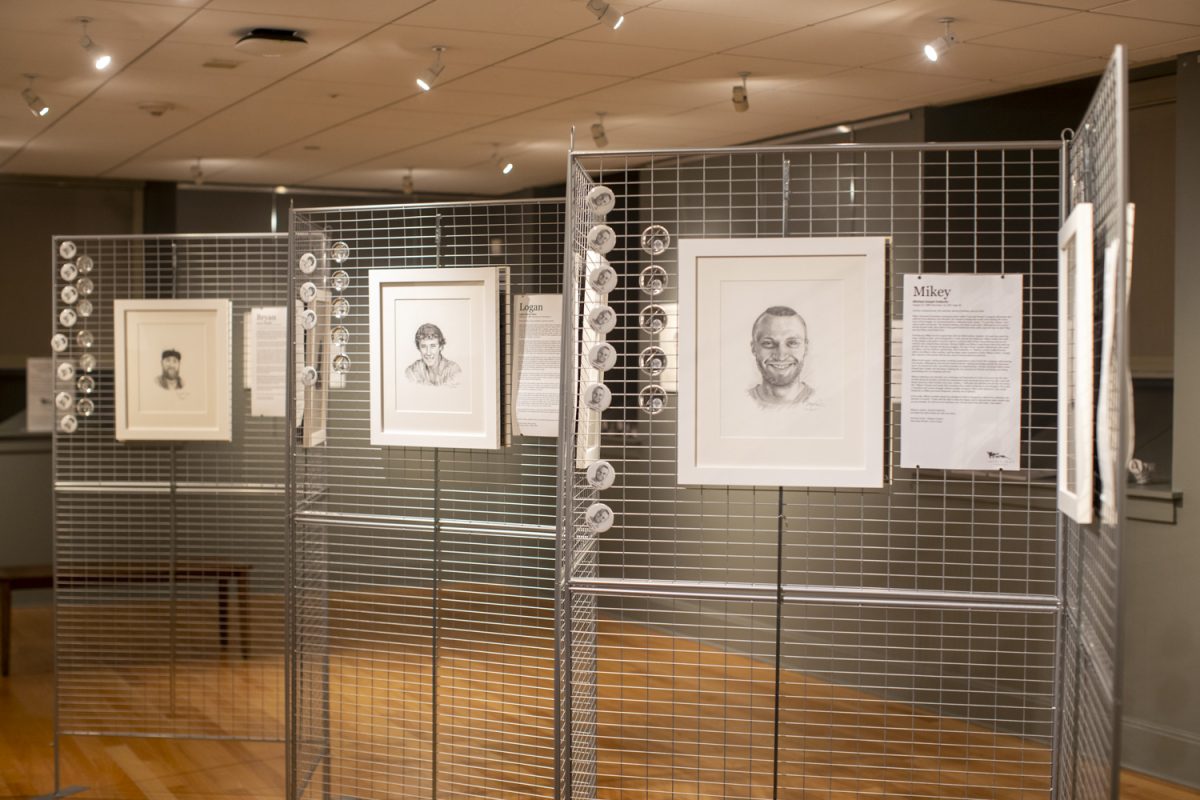Lined with 32 portraits of individuals who have died from substance use disorder, 31 of whom are from the state of Iowa, the Hanson Humanities Gallery located in the Iowa City Old Capitol Museum is filled with emotion. Alongside each portrait is a powerful narrative story about the life of each person featured.
The art is a part of the Into Light Project, an activism exhibit started by Theresa Clower that seeks to humanize the disease of addiction and spark conversation about the stigma that surrounds it.
The thirty-second portrait in the collection depicts Clower’s son Devin, who died in 2018 from an accidental overdose. Clower took up portraiture because of her son’s death, leading her to begin the Into Light Project.
“As a way of processing that loss, I took up portrait work and started with his portrait,” she said. “That led to what is now a national effort and push to really humanize addiction through the power of portraits and storytelling.”
The project partners with communities and galleries across the country to share the stories of individuals from each host state who have died as a result of substance use disorder, with the goal of having an exhibition in each of the 50 states.
Every person featured in the exhibit is depicted in graphite pencil, an intentional decision by Clower.
“[It is] very intentional, using graphite — the pencil — because we’re all made up of light and dark, and it’s our belief that no one should be judged just by their darkest moments,” Clower said. “It’s a metaphor for really how we approach things and the likeness within each person.”
Shawn Faust, a Delaware-based artist and a part of the Into Light Project, described the emotion involved in creating every piece.
“This is a real person, [with a] real story,” Faust said. “It is quite an honor to be entrusted with that, and a privilege, and so I use that emotion because again, I’m not drawing this as an artist. I’m kind of putting myself in the mindset of a parent, a brother, a father, to these individuals.”
Faust said the emotion that comes with learning about each individual and their story is just as important as any other artistic medium or tool. He expressed gratitude for his ability to be involved in the project.
“[In] 30 years as a portrait artist, I never felt this more purposeful for my talent than this project, and that’s why I’m just very, very grateful. So, yes, it’s emotional, but I embrace it, and I think it’s very important. Otherwise, it would really just be a rendering,” he said.
The Iowa exhibit operates as a conversation starter about substance use disorder and addiction across the state.
In 2022, there were 6,067 drug overdose-related emergency department visits in the state of Iowa alone, according to the most recent data from Iowa Health and Human Services.
Clower said because drug addiction is so stigmatized, it is often under-discussed. She said she wants the exhibits to provoke dialogue about the disease in each community and state they are in.
“We would like people to realize that it’s not a moral failing, that drug addiction is like I said, a mental health issue,” she said. “That’s one thing, just having more empathy, more sympathy, understanding that no one — my son included — wants to be addicted to drugs in the way that so many people are nowadays.”
Alison Lynch, a psychiatrist and clinical professor at the University of Iowa, was crucial in getting the Into Light project to Iowa City. She echoed Clower’s statements about the importance of increased awareness and discussion about substance use disorder, adding that addiction is everywhere.
“These are our neighbors, these are our family members, these are our friends. And if we don’t talk about it, it just isolates people. It makes people even more ashamed about asking for help, and then it makes [the disease of addiction] more lethal,” Lynch said.
She emphasized how under-discussed the topic is and how the Iowa City community can work toward a more informed culture surrounding substance use disorder.
“I think addiction is still one of those novel topics where it’s not everybody’s really comfortable [talking] about it,” Lynch said.
She mentioned how an educational setting, such as a college town, fosters the kind of thinking that is needed to grow as a community.
“To approach it from a state of curiosity and open-mindedness and being willing to learn and hear about somebody else’s perspective, I think is a really great way to learn about [addiction],” she said.
Lynch also works as the director of the UI Addiction and Recovery Collaborative, a division within the psychiatry department of the hospital, which provides clinical services, education, research, advocacy, and outreach to help individuals with substance use disorders.
Nichole Nidey, a UI professor in the epidemiology department, emphasized the importance of education surrounding substance use to recognize the signs of an overdose, saving lives.
Nidey explained that of the people who have died from an overdose in the state of Iowa, 85 percent of cases had an opportunity for intervention, according to the CDC. Naloxone or Narcan are the top ways to prevent an overdose.
“Being aware of substance use and risks of overdose and the signs of overdose could help us prevent those deaths,” Nidey said.
RELATED: Johnson County combats opioid overdoses with new Narcan distribution program
The Into Light exhibit also includes buttons you can take that show a portrait of the deceased individual and “Ask me about [name].” Visitors are encouraged to put the buttons on their backpacks or bags and are asked to share the story of the individual pictured when provoked. This is another way to increase education and conversation surrounding substance use disorder.
The exhibit will stay in the Old Capitol Museum through Dec. 19, 2025. Admission is free to the public.



